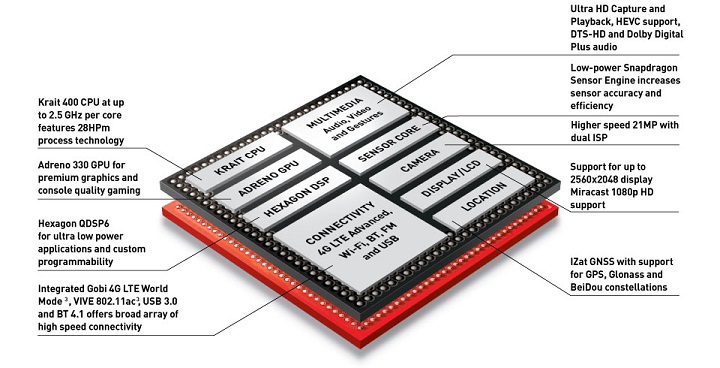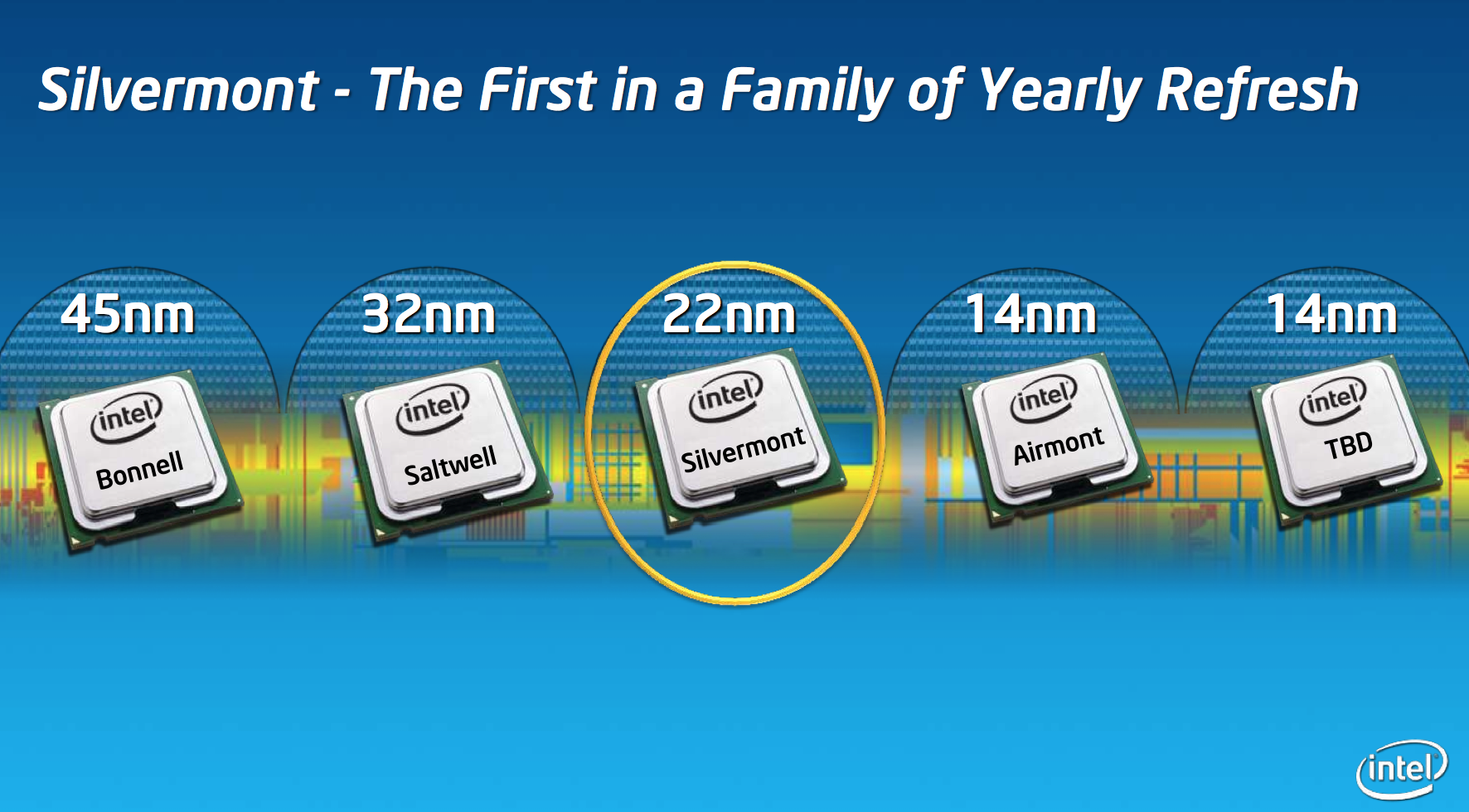On April 7, Qualcomm (QCOM 0.74%), the unequivocal leader in mobile chips, announced the details of its next-generation Snapdragon 810 phone/tablet processor. The chip is quite impressive, featuring four ARM Holdings (ARMH +0.00%) Cortex A57/A53 cores in a big.LITTLE configuration, a significantly beefed-up graphics processor, improved memory interface, and a whole host of other improvements across the board. However, despite how nice this part looks on paper, Intel (INTC 2.79%) now has a pretty interesting opportunity to strike.
Qualcomm moves to TSMC 20-SoC for 2015
As anybody who follows the processor market knows, new and improved transistor technologies are the single biggest drivers of dramatically improved performance per watt. Yes, you can do a lot with a superior architecture, but at the end of the day you end up maxing out what you can do on a given technology and need to advance.

Qualcomm's Snapdragon 801 really pushes TSMC's 28-nanometer HPm process. Source: Qualcomm.
Now, in moving from Taiwan Semiconductor's (TSM 0.61%) 28HPm to its 20-SoC process, Qualcomm gains about a 1.9-times increase in transistor density (i.e., Qualcomm can pack roughly twice as many transistors into the same space). This, combined with lower-power transistors, allows Qualcomm to offer a meaningfully higher-performing chip in roughly the same power envelope with the Snapdragon 810 compared with its prior-generation Snapdragon 801/805 products.
Intel will be on its 14-nanometer FinFET process by the end of 2014
While there has been a lot of hoopla surrounding the delay of about a quarter of Intel's 14-nanometer FinFET process for both high-performance CPU applications and the low-power SoC, the fact of the matter is that Intel is on track to go into high-volume production on these products this year. Indeed, Broadwell (the PC/Ultrabook product) is in production now, and there are even a bunch of samples of the first 14-nanometer Atom known as Cherry Trail being shipped around as we speak.
The first 14-nanometer product, Broadwell, is likely to start showing up in PCs and 1-socket servers by the end of the year. The first 14-nanometer mobile product, Cherry Trail, is likely to find its way into a handful of devices by the end of 2014, with broader availability during the first half of 2015. This suggests, particularly as Qualcomm is using the ARM Cortex A57 core, that Intel should have very little trouble offering superior performance at lower power consumption -- at least with respect to CPU/GPU performance in tablets.
What about phones?
Things get a little murkier when we talk about phones. Cherry Trail is a product that is aimed principally at tablets and above, so it looks as though Intel will have the 22-nanometer Silvermont-based Moorefield to compete for the first half of 2015. This will not be able to compete with Qualcomm's Snapdragon 810 on performance/features -- that's the job of Intel's Broxton.

Intel's roadmap outlining Broxton. Source: Intel.
Broxton, unlike Cherry Trail, is designed to work in both tablets and phones. It also features a next-generation CPU core known as Goldmont as well as Intel's in-house Gen. 9 GPU. At its investor meeting back in November, Intel's management was quite bullish on this part and specifically referred to it as a design targeted at "Hero Devices." The rub, though, is that silicon availability will be in "mid-2015."
Mid-2015 isn't enough for phones
With Intel using Moorefield to fight in the performance/mainstream part of the smartphone market during 1H 2015, and with Intel's SoFIA LTE (quad core Silvermont built on TSMC's 28-nanometer process) fighting in the value/entry segment, the company doesn't really have an answer to Snapdragon 810 until Broxton for phones.

Silvermont is expected to hold the line in phones during 2014 and most of 2015. Source: Intel.
The problem with "mid-2015" is that the "hero devices" that Intel covets are typically shown off at Mobile World Congress (in February) with availability in late Q1/early Q2. If silicon is not available until, say, June, then devices realistically won't hit the market until September. Unfortunately, this means that unless the handset vendors dramatically change their schedules, this means that Broxton "misses it by that much" for phones. It should do quite well in tablets, though.
Intel needs to pull in Broxton ... or bring Cherry Trail to phones
It should be top priority for the top brass at Intel to accelerate the time to market for Broxton as quickly as possible. Alternatively, Intel could bring the Cherry Trail platform to smartphones (where it would have more than enough performance to compete with Snapdragon 810) and then the company could stand to win some meaningful "phablet" designs for 2015.

Cherry Trail VMS ("value and mainstream") is on track for late Q4 2014. Source: VR-Zone.
However, given that the schedule for Broxton is already quite aggressive, given its proximity to Cherry Trail's launch, it may be unreasonable to expect a further pull-in. These things just take time, and Qualcomm's use of the stock ARM A57/A53 cores in Snapdragon 810 shows that this isn't easy for anybody. It may not be until 2016 (10-nanometer generation) that Intel has a meaningful advantage in mobile, and if Intel doesn't get the timing right, Broxton may not be the winner that Intel hopes.
